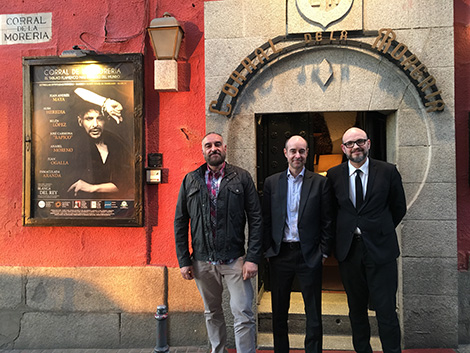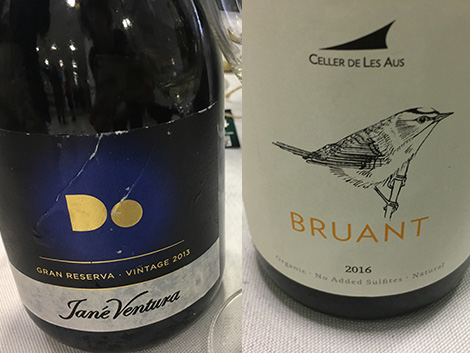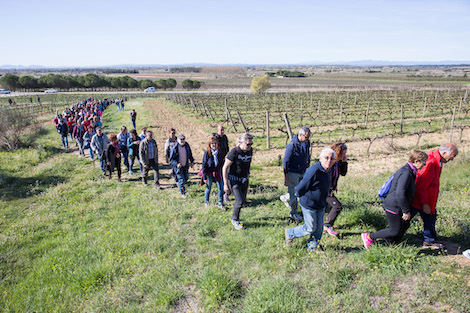
If you want to succeed publishing pictures of wine bottles in social media, go for expensive, rare old wines —the older, the better. When it comes to old sherry or other fortified wines from southern Spain, rarity is always a given because these wines were never intended for cellaring.
Corral de la Morería is a singular establishment that combines great food and wine with a superb flamenco show in Las Vistillas, a picturesque area in central Madrid. Owner Juan Manuel del Rey, who stocks a vast collection of old sherry and fortified wines in his Michelin-starred restaurant, acknowledges that old sherry is a growing trend. But he also makes it clear that these treasured bottles are irreplaceable.
Perhaps that is why those of us who were lucky to be present at a tasting featuring a selection of old sherry bottles at Enofusión wine fair in Madrid in late January felt so fortunate.
It was not a run-of-the-mill tasting. To start with, Del Rey and his team brought the festive spirit of Corral de la Morería to the functional room in the conference centre where Enofusión was held. As well as an array of dishes to match the wines, we witnessed an outstanding performance by flamenco dancer Eduardo Guerrero who filled the atmosphere with energy in a couple of seconds. But what struck us most was the quality and diversity of the wines we tasted. It was one of the best tastings of my life and I am sure I wasn’t the only one who thought that. It totally changed my perception of old sherry. Compared with the, at times, painfully concentrated old wines I tasted in Vinoble last year, this was all about complexity and velvety textures!
To pick their six-wine selection for Enofusión, Juan Manuel del Rey tasted 40 old wines alongside wine journalist and El Corral consultant Luis Vida (both are members of Los Generosos, a group of fortified wine lovers) and sommelier Santi Carrillo. Given their in-depth knowledge and day-to-day contact with old sherries, we have asked them to provide some guidance for wine lovers willing to delve deeper in theses wines.
Cask aging versus bottle aging
“The most important thing is to distinguish between cask ageing and bottle ageing because results vary,” Juan Manuel del Rey explains. “Tasting the two styles is key to understand the differences.”
According to Del Rey, the great advantage of cask-aged wines is that they are readily available in the market be it in the form of biological (under a veil of yeasts or flor) or oxidative ageing. “Biological ageing offers more complexity as far as the flor is preserved (Del Rey says the limit stands between 12 and 15 years), but when oxidation takes central stage the focus is on concentration and not all wines are necessarily good. Some may taste edgy and harsh, while others are surprising for their ability to combine power and balance.”
In contrast, bottle ageing adds “roundness, finesse and complexity”, according to Del Rey. As the tasting at Enofusión proved, these delightful wines feel far from the extreme flavours resulting from extended ageing in cask. In this sense they are more approachable and understandable.
The sad part is that there aren’t many bottles left because they were never meant to be collectors’ items. Consumers never considered them for this purpose, neither did most producers despite the fact that, as Del Rey points out, “in the 1940s and 1950s some bodegas were positive that their wines could develop in bottle.” González Byass is the only exception. The producer, who presented a collection of historical bottles at Vinoble last year, brought the rare 1911 Matusalem to the tasting at Enofusión.
“The greatness of a wine comes from its ability to age,” says Luis Vida. “We have spent years researching and exploring how old sherry and other fortified wines develop in bottle.” In 2016, Los Generosos held a tasting for over 100 wine lovers in Vinoble in which they compared existing brands with old bottlings from the same soleras. Members of the association enjoy hosting vertical tastings to see the evolution of a brand or solera over the decades.
Old fortified wines from Spain: a decalogue
These are a few useful tips that we picked up during an afternoon of pleasant chat at Corral de la Morería:
1. Biologically aged wines develop splendidly. Wines aged under a veil of yeasts or flor “are the most striking.” says Juan Manuel del Rey. “Their complexity sets them apart.” A good example is Agustín Blázquez Carta Blanca, which we tasted at Enofusión. An amontillado fino bottled in the 1960s it has pastry, creamy aromas followed by white chocolate, petrol and scrubland notes and a warming palate. According to Luis Vida, this is the result of exposing grapes to the sun for drying, a common practice in those days. “It was a natural, unfortified wine meant for demanding consumers,” he said. As you can seen on one of the photos above, the look and label reinforce this idea.
2. Unpretentious sherries that age well. Top wines were not the only ones to evolve beautifully in bottle. Take for instance Terry’s Maruja Solera Fina. A fino bottled around 1962, it was made with grapes from El Cuadrado plot in pago (single vineyard) Balbaína. It was a popular brand in its day, meant to be drunk soon after release, but it retains a distinctive iodine character with nutty and baked apple aromas followed by a briny, fine palate.
Our three experts strongly recommend the entry level brands of flagship producers like Agustín Blázquez or Pedro Domecq because they were always sourced from the very best vineyards.
3. Vineyard names and categories from yesteryear. The names of the vineyards are printed on the labels of many old bottles in Corral de la Morería’s collection —Miraflores and Macharnudo appear regularly. Other categories that are no longer used are amontillado fino (the equivalent of today’s tres palmas) or fino amontillado but our group of experts would love to see them again on the labels of 21st century wines.
4. Searching for the most reliable decades. The 1940s, 1950s and 1960s were the golden age of sherry, say Del Rey, Vida and Carrillo, but they remember some impressive bottlings from the 1970s (we tasted a bottle of La Ina from that decade with powerful umami, petrol and nutty notes, amazing depth and a velvety texture) and even from the 1980s. Dos Cortados Very Fine Dry Oloroso from Williams & Humbert bottled in 1983 was a real favourite at the Enofusión tasting: a wonderfully creamy wine with lots of life and a warming, spirit-like character.
5. How to tell when a bottle was released. This is a tricky question given that most sherries and other fortified wines are multi-vintage blends aged in the solera system. You really need to know your old bottles to be familiar with them. The first thing Juan Manuel del Rey checks is which material the capsule is made of —the oldest examples were made of lead and tin. The year of production of the bottles is usually engraved on the base so it can be inferred that the wine was bottled either that year or the next. Other clues include the tax slip sealing the cap or the label design.
6. Don’t mistake solera and vintage. This may seem pretty obvious for anyone vaguely familiar with sherry and other fortified wines, but Juan Manuel del Rey insists that it is still a common mistake among consumers. The fact that some old labels use the term añada instead of solera on the label (e.g.: "Añada 1730") does not make things any easier.
7. Legendary producers. What should a wine lover go for to taste a top-quality old sherry bottling? “Pedro Domecq is a safe bet because grapes were sourced from Macharnudo Alto, an outstanding grand cru,” says Luis Vida. Del Rey goes for Domecq’s Río Viejo, a wine that “lifts my spirits.” The name Macharnudo Alto was written on big letters on the label of the 1966 bottling we tasted at Enofusión. I don’t recall ever finding such finesse in an Oloroso. My tasting notes are condensed in a single word: unbeatable. La Ina is another legendary Domecq wine whose grapes were also sourced from Macharnudo. Our experts recommend all bottlings until the late 1970s. The current solera owned by Lustau “is no longer the same”, they add.
Another great producer, Agustín Blázquez, also sourced grapes from Macharnudo Alto. Although their vineyards lied lower than those of Domecq’s, Luis Vida emphasizes the remarkable finesse of the legendary Carta Blanca. “Tío Pepe bottlings from pago Carrascal were very dry and powerful with a nutty character and they also evolve beautifully,” they add. “Sometimes you have to wait 20 years for the flor to stay in the background,” Vida points out.
In terms of manzanilla, the trio mention La Gitana from the 1950s and 1960s. The wine was made in Sanlúcar with grapes from the Miraflores vineyard. Other recommended producers include Delgado Zuleta and Gaspar Florido from the late 1950s and the 1960s.
8. Tracking down soleras. With soleras and brands often changing hands in the Sherry Triangle, some wines are really difficult to track. Agustín Blázquez is a case in point. The house was bought by Pedro Domecq in 1973 who continued producing brands like the legendary Capuchino which was later sold to Osborne (see picture above with the brand under three different producers). Soleras were often split or detached from their brands. Successive purchases have resulted in a complex picture which only a handful of experts master. The book Sherry, Manzanilla & Montilla by Jesús Barquín and Peter Liem includes a handy chapter devoted to extinct producers. It features legendary names of yesteryear like Pedro Domecq, purchased by Allied-Lyons in 1994 or some of the bodegas which were previously bought by Domecq like Agustín Blázquez, GF or M. Antonio de la Riva, a name which is back thanks to the partnership of terroir-driven duo Willy Pérez y Ramiro Ibáñez.
9. Few vintage sherries and Montilla. Vintage sherries are extremely rare, with the exception of a few bottling produced by Gonzalez Byass or Garvey. It is also difficult to find old Montilla-Moriles bottles, the other traditional wine region from Andalusia. Out of around 700 selections, Juan Manuel del Rey's old bottle collection includes just about 70 to 80 bottles from Montilla.
10. “The supermarket sweep” of the 1970s. This is how Luis Vida and Del Rey describe the sharp reversal experienced by Jerez in this period. The arrival of standardized palomino clones, the loss of consistency of many soleras and a growing trend towards oxidation means an overall loss of quality in sherry wines. Other visible signs of decline include the disappearance of vineyard names on the labels and cost-cutting in bottles (thinner glass), corks and labels.
11. How much does an old Sherry bottle cost? Del Rey admits that prices have skyrocketed in recent years. A case in point is Carta Blanca by Agustín Blázquez: bottles from the 1940s, 1950s or 1960s that used to sell for €15 to €20 four years ago now cost no less than €120.
12. Not every old bottle is good, Del Rey warns, but Corral de la Morería is a good place to start. Five years ago, old sherry was included in the restaurant’s pairing menus. Social media and particularly Instagram have helped to popularise this style of wines and now many sommeliers are looking for old bottles.
So far, this trend is limited to Spain. Crucially, quantities of these wines are really tiny. “It feels like the last big feast of the end of the world because we are drinking wines that have almost ceased to exist,” Luis Vida says. Juan Manuel del Rey acknowledges that he trades with these old bottlings for passion rather than business. “Our job is to make people happy. Corral de la Morería combines three elements [food, wine and entertainment] that make us unique.”
Beyond old bottles, the restaurant’s wine list includes all of his favourite cask-aged wines and modern styles from the region. “If I've gotten myself into all this mess," Del Rey says, "it's because I think these are the most exciting wines in the world.”
OLD SHERRY AND FORTIFIES WINES - CARE AND SERVICE
Corral de la Morería painstakingly looks after their old bottle collection both in terms of preservation and service. Apart from the wines stored in the restaurant, Del Rey maintains a second cellar nearby where bottles are kept at 11º C with 70% humidity and two wine refrigerators. All bottles are stored upright.
Old bottles (as well as many cask-aged wines) are served with Coravin. The procedure is as follows: corks are removed, bottles refilled with argon and then they are recorked again to ensure that the cork is in perfect condition before being punctured with the Coravin. Wines with very light sediments that risk getting through the needle itself are not served with Coravin. In this case bottles are uncorked, the wine served and then refilled with argon and recorked as many times as necessary.
All the wines are previously tasted by Juan Manuel del Rey or sommelier Santi Carrillo to ensure that they are in pristine condition.

Amaya Cervera
A wine journalist with almost 30 years' experience, she is the founder of the award-winning Spanish Wine Lover website. In 2023, she won the National Gastronomy Award for Gastronomic Communication
Wine tastings in April 2019
NEWSLETTER
Join our community of Spanish wine lovers






